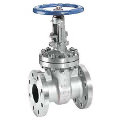
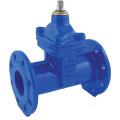
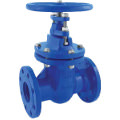
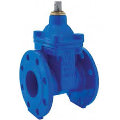
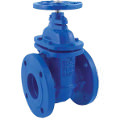
A gate is essentially a simple interception valve, and can be either fully closed or fully open. When fully open, the passage cross section is equal to the outlets, with negligeable pressure drops.
When they are employed as modulating valves, gates may cause high turbolent flow and, consequently, quick seats erosion, in addition to noisy and unpleasant vibrations of the closing wedge.
Because of its shape, the wedge adheres to the seats only at complete closure, thus avoiding any friction wich may damage the seats. In the most usual versions, the wedge can be massive or flexible. In the flexible version the wedge consists of two discs connected in their central parts only, and thus having a good peripheral flexibility wich allows a perfect matching to the seats.
The seal rings are usually obtained in the body, and are supplied in the material most suitable for their use.
The particular shape of the body bottom can receive any solid particle that the fluid may drag on the pipes bottom, so that these particles cannot scratch the seat during the closing phase, even if the lower part of the seat goes beyond the inlet and outlet flanges.
During the opening phase, and because of the pressure acting on the large surface wedge, the friction between wedge and seats can be higher enough to hinder or hamper the operation: in this case, and especially in case of big sizes or high pressures, a by-pass balancing the pressures acting on the two faces of the wedge can be installed.
Except for few rapid-operation special types, the wedge is usually driven by a thread stem. The stem can be "non rising/inside screw" type, when the yoke nut is held by the wedge, or "rising/outside screw" type.
In the "inside screw" type, the thread side of the stem is in contact with the fluid, that cannot consequently be corrosive, not to endanger the gate functioning. In this case the gate dimension is constant.
In the "outer screw" type the stem is linked to the wedge by means of a pin joint and the screw is not in contact with the fluid. The gate dimension is slightly larger than the outlet bore, and can visually indicate the valve opening degree. The yoke nut is held by a yoke with particularly elastic arms, so that the gate cannot be blocked in the close position by thermal expansion.
Sometimes, when the wedge in completely raised, it works as a back-locker on the inside part of the bonnet, thus allowing the gland gaskets replacement with fully open gate.
In the "parallel seats" gates, the wedge is substituted by two parallel discs, slipping with no friction between the seal rings. The fluid pressure, or a proper device, will push the discs against the rings only when the gate is in its close position.
